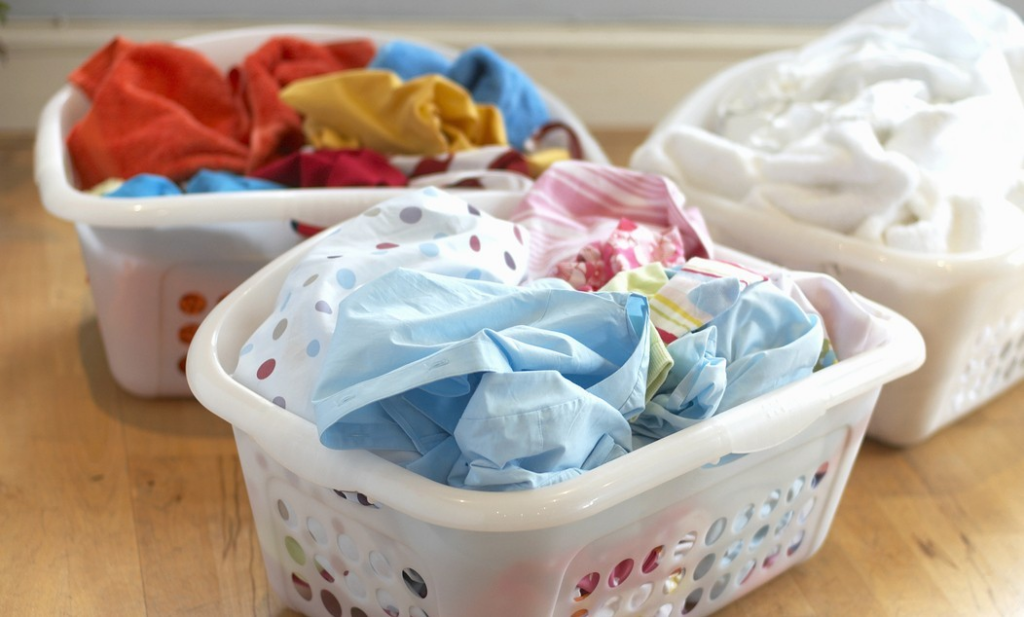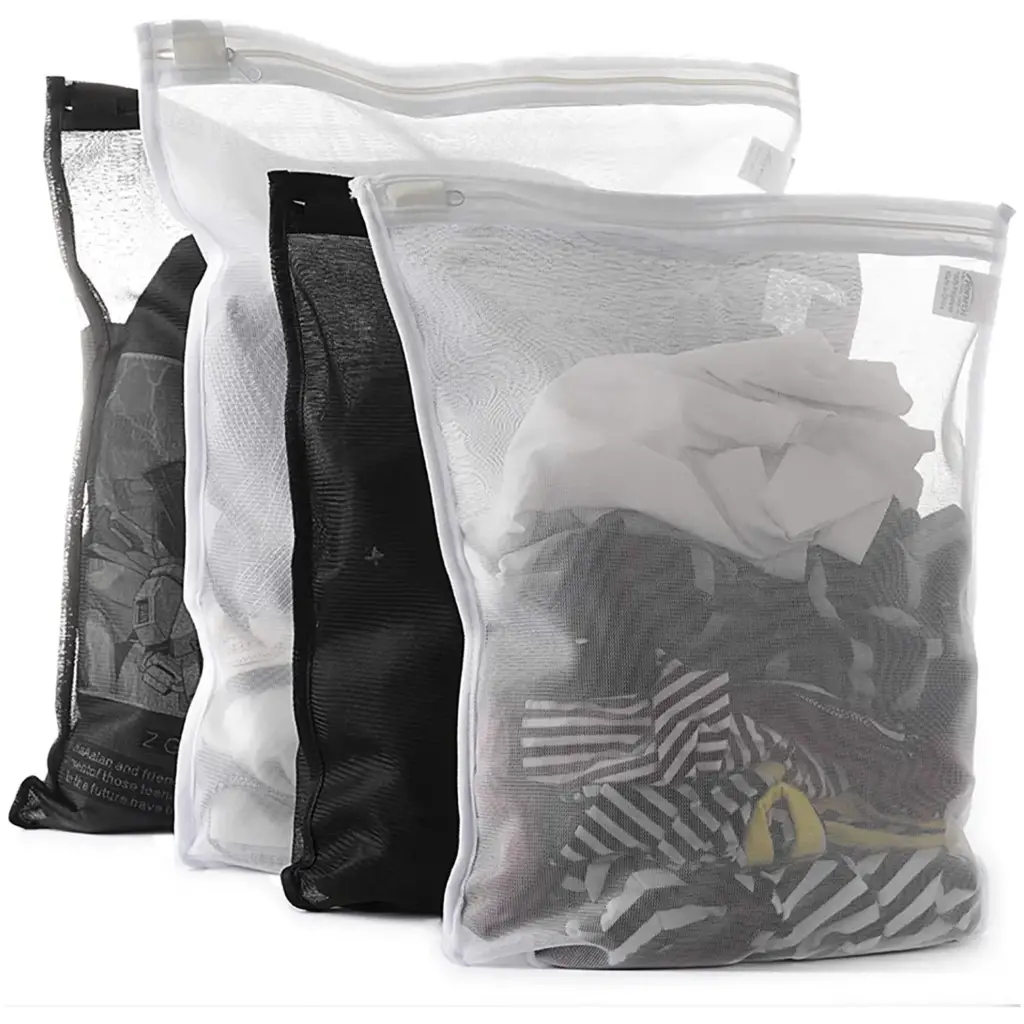Standing in front of my overflowing laundry basket, I notice the delicate fabrics peeking out beneath the weight of the rest. These fabrics symbolize fragility and require special attention and care. The thought of ruining these precious pieces is enough to make anyone cringe.
Luckily, I’ve gathered 14 helpful tips to ensure gentle care for your delicate laundry. From sorting to storing, these tips will guide you through the process and help you maintain the quality of your delicate items.
Let’s embark on this journey together and discover how to give our delicate laundry the Tender Loving Care (TLC ) it deserves.
Sort Your Delicates by Fabric Type

When sorting your delicates, it’s important to categorize them based on their fabric type. This ensures that each item receives the proper care it needs and prevents any potential damage.
One important thing to consider when sorting delicates is the size of the bag you use. It’s highly recommended to use a mesh laundry bag, as it provides a protective barrier during the wash cycle.
The bag should be big enough to fit the delicate items without overcrowding them. This allows for enough water circulation and prevents any unnecessary stretching or distortion.
Another important reason to sort delicates by fabric type is to avoid color bleeding. Mixing different fabrics in the same load can cause colors to bleed onto each other, leading to unwanted discoloration. By separating items based on their fabric type, you reduce the risk of color transfer and preserve the original colors of your delicates.
To make the sorting process easier, you can create separate piles for different fabric types. For example, group silk, lace, and sheer items together, while placing cotton and synthetic materials in another pile. This way, you can quickly identify which items need extra care or specific washing instructions.
Use a Gentle Detergent for Delicate Fabrics
Now that I’ve sorted my delicate clothes by fabric type, it’s important to choose a gentle detergent made specifically for delicate fabrics. Using the right detergent will ensure that my delicate items are cleaned effectively without causing any damage.
When selecting a gentle detergent, there are a few options to consider.
One option is to use a mild liquid detergent that doesn’t contain harsh chemicals or additives. These gentle detergents are designed to be gentle on fabrics while still providing effective cleaning power.
Another alternative is to use a detergent specifically formulated for delicate items. These detergents are often labeled as ‘delicate’ or ‘gentle’ and are created to protect the fibers of delicate fabrics.
If I prefer to hand wash my delicate items, there are also gentle detergent options available. These detergents are specifically made for hand washing and are usually milder than regular detergents.
When hand washing, it’s important to use a gentle detergent and follow proper hand-washing techniques. This includes using lukewarm water, gently agitating the fabric, and rinsing thoroughly.
Hand Wash Delicate Items When Possible

If possible, I prefer to hand wash my delicate items. It allows me to give them the extra care and attention they need, ensuring their longevity and preserving their delicate fabrics. Hand washing delicate items is a gentle alternative to machine washing because it reduces the risk of damaging the fabrics or causing them to lose their shape.
When hand washing delicate items, it is important to use a mild detergent specifically designed for delicate fabrics. This will help protect the fibers and prevent any harsh chemicals from causing damage. Also, using lukewarm or cold water is ideal since hot water can cause shrinkage or fading.
To emphasize the importance of hand washing delicate items, here is a table showcasing some alternatives to hand washing and their benefits:
| Hand Wash Alternative | Benefits |
|---|---|
| Delicate cycle on the washing machine | Provides a gentler option for delicate items |
| Mesh laundry bags | Protects delicate items from tangling or snagging during machine washing |
| Dry cleaning | Appropriate for items with intricate beading or delicate trims |
Use Cold Water for Washing Delicates
I always choose cold water when washing delicate items to ensure their protection and longevity. Using cold water has several benefits for washing delicate laundry:
- Preserve color: Cold water helps prevent color fading and bleeding, keeping your delicate items vibrant and beautiful.
- Minimizes shrinkage: Hot water can cause fabrics to shrink, but cold water helps maintain their original size and shape.
- Prevents stretching: Delicate fabrics like silk and lace can easily stretch when exposed to hot water, but washing them in cold water helps prevent this issue.
- Gentle on fabrics: Cold water is less harsh on delicate fabrics, reducing the risk of damage or wear and tear.
- Bag size options: When washing delicates, consider using a mesh laundry bag to provide an extra layer of protection. These bags come in various sizes, allowing you to choose the one that best accommodates your delicate items.
Avoid Using Bleach or Harsh Chemicals
To protect your delicate laundry items, it’s best to avoid using bleach or harsh chemicals. Bleach can weaken the fibers of your delicate fabrics, causing them to become worn and damaged over time. Instead, choose gentler alternatives and techniques for removing stains that will preserve the integrity of your delicate items.
Here are some alternatives to bleach and gentle stain removal techniques that are effective without the risk of damaging your delicate garments:
- Hydrogen peroxide: A great alternative to bleach, it works well on tough stains like blood or wine.
- White vinegar: Can be used to remove odors and brighten fabrics.
- Baking soda: A versatile alternative that can remove stains, neutralize odors, and act as a gentle fabric softener.
- Oxygen-based cleaners: Safe options for brightening whites and removing stains, such as OxiClean.
- Borax: Another option for stain removal.
Using these alternatives will help you maintain the quality of your delicate laundry items while still effectively removing stains. Remember to always follow the care instructions on your garments and test any new products or techniques on a small, inconspicuous area first.
Use a Lingerie Bag for Added Protection

Using a lingerie bag is essential for protecting delicate items during the laundry process. It’s important to consider the size and material of the bag.
A smaller mesh bag works well for bras and underwear, while a larger, sturdier bag is better for slips and camisoles. This added protection prevents damage and extends the lifespan of your delicate lingerie.
Bag Size and Material
For better protection, consider using a lingerie bag when washing delicate items. Lingerie bags come in different sizes, so you can choose the one that suits your needs. Here are some size options to consider:
- Small: Perfect for delicate lingerie pieces or small items like socks and underwear.
- Medium: Ideal for delicate clothing items like blouses or shirts.
- Large: Great for larger items such as dresses or sweaters.
- Extra-large: Suitable for bulky items like coats or blankets.
- Set: A set of multiple sizes that offers versatility for different types of delicate items.
When it comes to bag material recommendations, go for a soft and durable material like mesh. This allows water and detergent to flow through easily while protecting your delicate laundry. Mesh bags are also breathable, preventing any potential damage caused by excessive heat or moisture.
Proper Loading Technique
When handling delicate laundry, it’s important to use a proper loading technique for optimal protection. One effective method is to use a lingerie bag.
This small, mesh bag is designed specifically for delicate items like lingerie, hosiery, and other fragile garments. By placing your delicate laundry inside the bag before putting it in the washing machine, you can prevent stretching and damage caused by rough agitation.
The bag acts as a protective barrier, allowing the water and detergent to flow through while keeping the delicate fabrics safe from harsh movements. Simply zip up the bag and place it in the machine along with your other laundry.
This way, you can have peace of mind knowing that your delicate items are receiving the gentle care they deserve.
Choose a Delicate Cycle on Your Washing Machine
To properly care for delicate fabrics, choose the delicate cycle on your washing machine. This cycle is designed to gently agitate and minimize the risk of damaging your delicate items. Here are some tips to optimize your delicate cycle:
- Use a laundry bag: Before placing delicate items like lingerie or lace garments in the washing machine, place them in a laundry bag. This provides an additional layer of protection and prevents tangling or stretching.
- Select the right bag size and material: Opt for a mesh laundry bag that comfortably accommodates your delicate items without overcrowding. The mesh material allows water and detergent to flow through, ensuring a thorough clean.
- Separate by color: Sort your delicate items by color to prevent color bleeding or fading. Wash light-colored items together and dark-colored items separately.
- Adjust water temperature: Use cold water for delicate fabrics to prevent shrinkage or damage. Hot water can cause certain materials to lose their shape or color.
- Follow sweater drying techniques: After washing delicate sweaters, lay them flat on a clean towel to dry. Avoid wringing or twisting them to remove excess water, as this can stretch or misshape the fabric.
It is important to note that these guidelines are specifically for delicate fabrics. By following them, you can ensure that your delicate items receive the care they deserve and maintain their quality over time.
Skip the Spin Cycle or Use a Low-Speed Setting
When caring for delicate fabrics, it’s important to decide whether to skip the spin cycle or use a low-speed setting on your washing machine. Delicate fabrics like silk, lace, or cashmere need extra care to maintain their shape and texture.
By skipping the spin cycle or using a low-speed setting, you can prevent unnecessary damage and keep your delicate items looking their best.
Instead of using the spin cycle, you can manually squeeze out excess water from your delicate garments. Gently press the fabric between your hands or roll it up in a clean towel to absorb the moisture. This method takes more time but is effective in protecting delicate fabrics from the harsh spinning motion.
Another option is to use a low-speed setting on your washing machine. This setting reduces the speed of the spin cycle, minimizing the force exerted on your delicate items.
Using a low-speed setting has several benefits, including less agitation, reduced tangling, and decreased friction between the fabrics. This gentle approach helps preserve the delicate fibers and prevents stretching or tearing.
Air Dry Delicate Items to Prevent Damage
Air drying delicate items is a great way to prevent damage. It has many benefits over machine drying and is highly recommended. Here’s why air drying is the best choice:
- Gentle on fabrics: Air drying helps delicate items maintain their shape and texture without the use of harsh heat or tumbling.
- Prevents shrinkage: Delicate fabrics like silk or lace can shrink when exposed to high heat in a dryer. Air drying eliminates this risk.
- Extends garment lifespan: Machine drying can cause wear and tear on delicate fabrics, leading to faster deterioration. Air drying helps preserve the quality and longevity of your favorite pieces.
- Saves energy: By avoiding the dryer, you not only protect your delicate items but also reduce your energy consumption and carbon footprint.
- Cost-effective: Air drying is free and requires no special equipment. It’s a budget-friendly way to care for your delicate laundry.
Avoid Hanging Delicate Fabrics to Dry

Air drying delicate items is highly recommended, but it’s important to avoid hanging certain fabrics to dry. Delicate fabrics, like silk, lace, and cashmere, need extra care to maintain their delicate nature. Hanging these fabrics to dry can cause stretching, loss of shape, or even tearing. To prevent this, it’s essential to use alternative drying methods.
One effective way to dry delicate fabrics is by using a mesh laundry bag. These bags come in various sizes and materials, making it easy to find one that suits your needs. Simply place the delicate item inside the bag and secure it tightly. This will protect the fabric from potential damage while allowing air to circulate freely.
Another important factor to consider is the proper loading technique. Avoid overloading the bag, as this can lead to excessive friction between the delicate fabrics. Instead, load the bag with only a few items at a time, ensuring there’s enough space for the air to flow through.
Lay Flat to Dry Delicate Sweaters or Knits
When drying delicate sweaters or knits, it’s important to use the right technique to prevent stretching or misshaping.
Lay them flat to dry instead of hanging them to avoid any unnecessary pulling or sagging.
This method preserves the shape and integrity of delicate knits effectively.
Sweater Drying Techniques
To dry delicate sweaters or knits properly, it’s best to lay them flat. This gentle drying technique helps maintain the shape and integrity of the delicate fabric. Here are some tips to ensure your sweaters or knits dry perfectly:
- Gently squeeze out excess water without wringing.
- Lay the sweater flat on a clean, dry towel.
- Gently reshape the sweater by patting it into its original shape.
- Avoid hanging the sweater, as it can stretch and lose its shape.
- Allow the sweater to air dry completely before storing or wearing.
Preventing Stretching and Misshaping
To prevent stretching and misshaping, it’s important to lay delicate sweaters or knits flat to dry. This gentle drying method helps maintain the shape and structure of the garment, preventing any unwanted stretching or distortion. Laying sweaters flat also helps prevent color fading and pilling, ensuring that your favorite knits stay vibrant and cozy for longer.
Here are some tips to prevent stretching and misshaping when drying your delicate sweaters or knits flat:
- Use a clean towel: Place a clean towel on a flat surface and gently lay your sweater on top. The towel will absorb excess moisture.
- Reshape as needed: While the sweater is drying, gently reshape it to its original form to ensure it retains its desired silhouette.
- Avoid direct sunlight: Keep your sweater away from direct sunlight to prevent color fading.
- Be patient: Allow your sweater to dry naturally and avoid wringing or squeezing it, as this can cause stretching and misshaping.
Best Practices for Delicate Knits
After making sure that your delicate sweaters or knits are laid flat to dry, it’s important to follow best practices to maintain their quality and longevity.
Here are some tips to help you care for your delicate knits:
- Use a gentle detergent made for delicate fabrics like silk.
- Handwash your delicate knits in cold water to avoid damaging the fibers.
- Gently squeeze out excess water instead of wringing or twisting the garment.
- To remove stains from delicate knits, gently blot the stain with a clean cloth and a mild stain remover, then rinse thoroughly.
- Avoid hanging delicate knits as it can cause them to stretch and lose their shape.
- Instead, lay them flat on a clean towel or mesh drying rack.
Iron on Low Heat or Use a Steamer for Delicate Fabrics
When caring for delicate fabrics, it is crucial to use a low heat setting on your iron or utilize a steamer. Delicate fabrics, such as silk, lace, and chiffon, require extra attention to avoid damage. Ironing techniques and steaming play a significant role in preserving the quality and longevity of these fabrics.
Ironing delicate fabrics requires a gentle touch. Set your iron to the lowest heat setting and ensure there is no water in the iron’s reservoir. Place a clean cloth or pressing cloth over the fabric to protect it from direct heat.
Gently press the iron on the cloth, moving it back and forth instead of dragging it across the fabric. This method helps avoid snagging or stretching the delicate fibers.
Alternatively, using a steamer can be an excellent option for delicate fabrics. Steaming softens and relaxes the fabric without the risk of direct heat. It also helps to remove wrinkles and restore the fabric’s natural drape.
Hang the delicate garment on a hanger and hold the steamer a few inches away from the fabric. Move the steamer up and down, allowing the steam to penetrate the fibers evenly.
Remember, when it comes to delicate fabrics, it’s better to be safe than sorry. Always test a small, inconspicuous area of the fabric before ironing or steaming the entire garment. By using proper ironing techniques or utilizing a steamer, you can keep your delicate fabrics looking fresh and beautiful for years to come.
| Ironing Techniques | Steaming Benefits | |
|---|---|---|
| Heat setting | Low | No risk of scorching delicate fabrics |
| Protection | Pressing cloth | Softens and relaxes the fabric |
| Movement | Back-and-forth | Avoid snagging or stretching delicate fibers |
| Wrinkle removal | Yes | Yes |
| Fabric care | Gentle | Softens and relaxes fabric |
| Durability | Preserves quality | Restores natural drape |
Store Delicates in a Cool, Dry Place
I always store my delicate garments in a cool, dry place to ensure their longevity and prevent any damage. Proper storage is important for maintaining the quality of delicate fabrics. Here are some tips to help you store your delicates effectively:
- Use a storage bag that’s spacious enough to accommodate your delicate garments without crowding them. This will prevent any unnecessary creasing or stretching.
- Opt for a storage bag made of breathable fabric, such as cotton or linen. Avoid plastic bags as they can trap moisture and promote the growth of mold and mildew.
- Store your delicates away from direct sunlight, as prolonged exposure can fade colors and weaken fibers. Find a cool, dark place like a closet or drawer to keep them safe.
- Moisture can lead to musty odors and bacteria growth. Ensure your storage area is dry and free from dampness to protect your delicate garments.
- Take extra care with accessories like lace, beads, or sequins. Consider using small individual bags or compartments within your storage bag to prevent any damage.
Handle Delicate Items With Care When Folding or Storing
When handling delicate items, it’s important to fold them carefully to avoid damage.
You can also protect these items by storing them in soft fabric pouches or using acid-free tissue paper.
Proper Folding Techniques
To ensure the longevity of delicate items, handle them with care when folding or storing them. Proper folding techniques are important to prevent damage during handling. Here are some helpful tips to keep your delicate laundry in good condition:
- Fold carefully: Take your time to fold each item neatly, creating even creases.
- Use tissue paper: Place tissue paper between layers of delicate fabrics to prevent friction and minimize wrinkles.
- Avoid hanging: Instead of hanging, fold delicate items like silk or lace to prevent stretching or distortion.
- Store in breathable containers: Use cotton or linen storage bags to allow air circulation and prevent moisture buildup.
- Sort by fabric type: Separate delicate items by fabric type to avoid color bleeding or snagging.
Choosing Suitable Storage Options
When storing delicate laundry, it’s important to consider a few key factors. First, opt for storage bags that are spacious enough to accommodate your folded items without overcrowding them. This will prevent creasing or damage.
Choose storage bags that are made of soft, breathable materials to allow proper air circulation and prevent musty odors or mildew.
Labeling your bags will also make it easier to find specific items later on.
Preventing Damage During Handling
Handling delicate items requires careful attention to prevent damage. To help you handle your delicate laundry with care, consider the following tips:
- Sort before folding: Separate delicate items from heavier ones to prevent tears and snags.
- Minimize folding: Reduce the number of folds to avoid creases and wrinkles.
- Use soft surfaces: Place a clean towel or mesh drying rack underneath delicate items to minimize friction and protect them from rough surfaces.
- Handle with clean hands: Ensure your hands are clean and dry before touching delicate fabrics to prevent stains or dirt transfer.
- Avoid overcrowding: Give your delicate items enough space when storing to prevent crushing or damage.
Conclusion
Taking gentle care of delicate laundry is essential for maintaining the quality and longevity of these garments.
By following the helpful tips provided in this article, such as using a gentle detergent, washing on a delicate cycle, and air drying, individuals can ensure that their delicate laundry items remain in pristine condition.
This not only saves money by preventing the need for frequent replacement but also allows individuals to continue enjoying their favorite delicate garments for years to come.
With a little extra care, your delicate laundry can stay beautiful and last for years to come.















